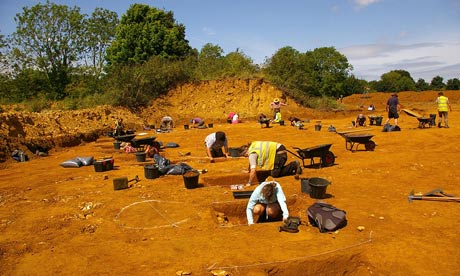The most intensive investigation ever undertaken of Britain's largest iron age hill fort is expected to reveal new details of how Britons lived 2,000 years ago – and maybe even that they were almost as suburban as we are.
Stretching across 80 hilltop hectares, behind three miles of ramparts, the fort, at Ham Hill in Somerset, and the outline of its history have been known for many years.
The Durotriges tribe, which lived on the hill, was subdued in AD45 by soldiers of the 2nd Legion under the command of the future emperor Vespasian, but what the Romans found there: a street system lined with houses on their own plots of land, is what archaeologists from Cambridge and Cardiff universities hope to uncover more fully in excavations over the next three summers.
"There was a main road going through and regular enclosures with round houses in them – it looks rather like suburbia," said Christopher Evans, director of the Cambridge Archaeological Unit. "We are not going to find Conan Doyle's Lost World up on the plateau."
As the ramparts were much too extensive for the occupants of the hill to defend on their own, attention is turning to whether the people who lived there were actually developing a community or collective identity for themselves. Although there have been bronze age finds from an earlier era, it is still not known when the hill was occupied and the ramparts built.
Niall Sharples from Cardiff university's school of history, archaeology and religion said: "It is a bit of an enigma. Ham Hill is so big that no archaeologist has ever really been able to get a handle on it. As a result there has never been a thorough campaign of excavations and nobody knows how the settlement was organised inside.
"People think of these places as defensive structures, but it is inconceivable that such a place could have been defended. Thousands of people would have been required: militarily it would have been a nightmare. Clearly it was a special place for people in the iron age: but when did it become special, why and how long did it stay that way?"
The initial dig this summer has uncovered human remains, including one full skeleton and the bones of a dog, as well as artefacts from domestic life including tools and pottery. The inhabitants had paddocks for animals and grain storage pits.
The archaeology excavation, which is focusing on a one hectare area, will take place under the eyes of walkers and visitors to a country park which now covers the hill, just west of Yeovil.
There is an open day with tours this Saturday between 11 am and 4pm, and information boards at the site and eventually iPod talks will allow people to follow the progress of the dig.
The excavation is being funded by a local quarrying company which wants to open up part of the hill so that it can continue to provide the distinctive local hamstone which has been used for building in the area since Roman times.
For more interesting topics related to archaeology, visit archaeology excavations.
Archaeology excavation is best known and most commonly used within the science of archaeology. In this sense it is the exposure, processing and recording of archaeological remains.
Sunday, September 11, 2011
Iron age hill fort excavation reveals 'possible suburbia'
Subscribe to:
Post Comments (Atom)

No comments:
Post a Comment